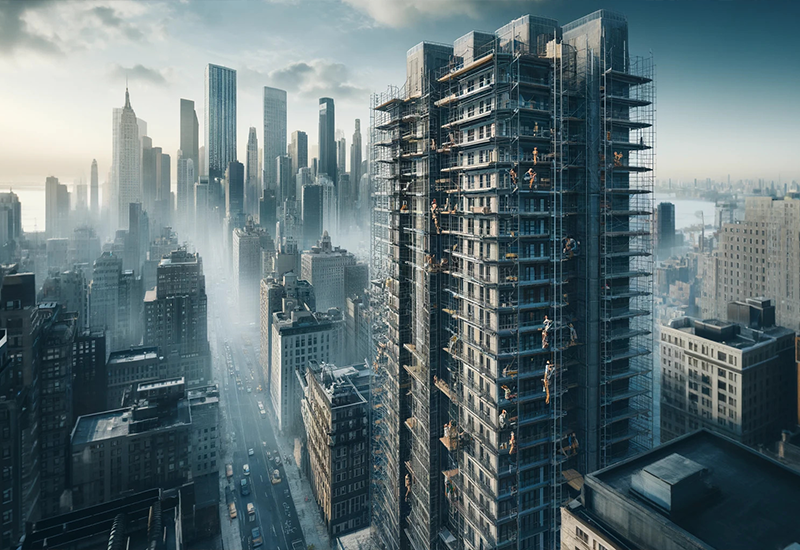
Ever heard of Local Law 11 and wondered what it’s all about? Well, you’re in the right place to find out! Local Law 11, or the Facade Inspection Safety Program (FISP), is like a health check for buildings in New York City over six stories. It’s there to make sure building facades are safe and sound, protecting pedestrians and residents from potential hazards. This crucial law mandates regular inspections and repairs to keep those towering structures in tip-top shape. Stick around as we dive deep into what Local Law 11 means for building owners and the city.
Table of Contents
Understanding Local Law 11: History and Purpose
Hey, have you ever wondered why those big buildings in New York City always seem to be under inspection? Well, it’s largely thanks to Local Law 11. Back in 1980, NYC faced a real problem with building facades literally falling apart. Pretty scary, right? After some serious incidents, the city said, “Enough is enough!” and introduced this law. But they didn’t stop there. In 1998, they gave it a bit of a makeover, making sure buildings not only got checked out but fixed up too. It’s all about keeping the sidewalks and streets safe for folks like you and me.
Quick Glance: Key Components of Local Law 11
Before we dive deeper, let’s take a quick look at the main points of Local Law 11:
| Aspect | Description |
| Applicability | Applies to buildings over six stories in New York City. |
| Inspection Frequency | Inspections are required every five years. |
| Inspection Categories | Facades are classified as Safe, Safe With a Repair and Maintenance Program (SWARMP), or Unsafe. |
| Compliance Requirements | Unsafe conditions must be repaired within 90 days, followed by filing a technical report. |
| Penalties | Non-compliance can lead to heavy fines and legal consequences. |
| Potential Benefits | Improved safety, potential increase in property value, opportunities for sustainable upgrades. |
This table gives you a snapshot of what Local Law 11 is all about. Now, let’s get into the nitty-gritty and explore each of these points in more detail.
Who Is Affected?
Now, you might be thinking, “Does this law affect all buildings?” Not exactly. It zeroes in on the taller ones – those over six stories high. So, if you own a skyscraper or any building taller than your average six-story building, you need to listen up. The law says you’ve got to have the exterior of your building, including those balconies, terraces, and overall facades, inspected regularly. And hey, if they find something wrong, you can’t just shrug it off – you need to get it fixed. It’s all about preventing potential mishaps and keeping everyone safe.
Inspection Process and Compliance: Getting Down to the Nitty-Gritty

Dive into the essential steps of the inspection process under Local Law 11. It’s all about ensuring your building isn’t just passing the test but excelling in it, keeping everyone inside and around it safe.
Inspection Criteria: What’s the Drill?
So, every five years, building owners in NYC need to call in the experts – I’m talking about licensed professionals who know their way around building exteriors. These pros come in, take a good look at the building’s facade, and give it one of three labels: Safe (meaning all’s good), Safe With a Repair and Maintenance Program (SWARMP, which is a fancy way of saying it’s okay but needs some TLC), or Unsafe (red flag alert!). It’s kind of like a report card for your building.
Compliance Steps: What Happens if You Don’t Play Ball?
Ignoring this law? Not a good idea. If your building’s facade is marked unsafe and you just sit on it, expect some serious fines and, let’s just say, not-so-pleasant legal headaches. You’ve got 90 days to fix whatever’s wrong and then show the city you did your homework by filing a report. It’s all about keeping everyone out of harm’s way.
The Role of Local Law 11 in Building Maintenance: More Than Just Compliance
Discover how Local Law 11 reshapes building maintenance strategies. It’s not just about ticking boxes; it’s a proactive approach to safeguard your property and enhance its longevity.
Preventive Measures: Staying One Step Ahead
Local Law 11 isn’t just about finding problems; it’s about stopping them before they start. Think of it like going to the doctor for a check-up. Regular inspections help catch small issues before they turn into big, costly emergencies. It’s all about playing it smart and safe.
Cost Implications: Pay Now, Save Later
Sure, keeping up with Local Law 11 can hit the wallet. Regular inspections, repairs – it adds up. But think of it this way: you’re investing in your property’s health. By budgeting for these check-ups and fixes, you’re avoiding bigger expenses down the road, not to mention keeping your tenants happy and safe. It’s a bit of short-term pain for long-term gain.
Legal and Financial Implications: What’s at Stake?
Learn about the serious consequences of overlooking Local Law 11. We’re talking fines and legal responsibilities here, highlighting the importance of staying on top of facade maintenance.
Penalties for Non-Compliance: Better Safe Than Sorry
So, what happens if you decide to play hooky with Local Law 11? Let me tell you, it’s not pretty. We’re talking hefty fines that can make your bank account weep and a legal mess that’s a real headache. And it gets more serious. If an accident happens because you didn’t keep your building’s facade in check, guess who’s on the hook? Yep, you, the building owner. It’s a big responsibility, but hey, it’s all about keeping everyone safe.
Financial Assistance and Programs: A Helping Hand
Now, don’t let the potential costs scare you. NYC knows that keeping up with Local Law 11 can be a tall order, especially for your wallet. That’s why there are various programs and financial aids floating around to help building owners like you stay compliant. These can range from loans to grants, giving you a leg up in ensuring your building meets the law’s standards.
Local Law 11 and Sustainable Building Practices: A Greener Tomorrow

Explore the intersection of Local Law 11 with sustainable building practices. It’s an opportunity to not just comply with the law but also contribute to a more eco-friendly and energy-efficient urban landscape.
Green Initiatives: Safety Meets Sustainability
Here’s a silver lining: complying with Local Law 11 isn’t just about playing by the rules; it’s a chance to go green. When you’re fixing up your building’s facade, why not think about sustainable options? It’s like hitting two birds with one stone – you enhance safety and contribute to a healthier planet.
Energy Efficiency: Save the Planet, Save Some Cash
Making your building more energy-efficient under Local Law 11 is a smart move. You see, when your building runs more efficiently, you’re not just cutting down on energy consumption (which is great for Mother Earth), but you’re also looking at potential savings in your energy bills. It’s an investment today for a brighter, greener, and more cost-effective tomorrow.
Conclusion
So, now you know what it’s all about! This isn’t just a set of rules to follow but a vital measure for maintaining building safety and integrity in NYC. By ensuring regular inspections and necessary repairs, Local Law 11 plays a key role in safeguarding the urban environment. For building owners, it’s a call to action for responsible maintenance and a step towards a safer, more sustainable city. Remember, this is not just about compliance; it’s about a commitment to safety and community well-being.
FAQs
Q: What buildings fall under Local Law 11?
A: Buildings in New York City over six stories. This covers residential, commercial, and mixed-use structures.
Q: What are the penalties for ignoring Local Law 11?
A: Non-compliance can lead to significant fines and legal issues. Owners are accountable for facade safety.
Q: How often are inspections required under Local Law 11?
A: Inspections are mandated every five years for applicable buildings to ensure safety and compliance.
Q: Does adherence to this law impact property values?
A: Yes, proper maintenance under these regulations can boost a building’s value and appeal.
Q: Are sustainable practices part of this law’s compliance?
A: Indeed, the law encourages incorporating eco-friendly measures during repairs and upgrades.


